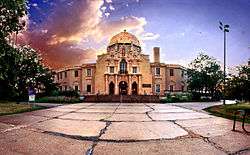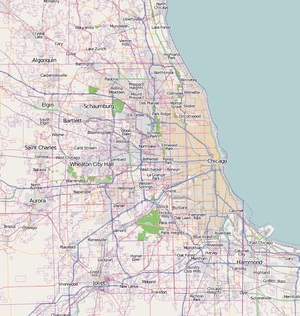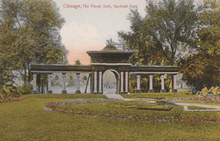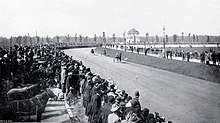Garfield Park (Chicago)
Garfield Park is a 184-acre (0.74 km2) urban park located in the East Garfield Park neighborhood on Chicago's West Side. It was designed as a pleasure ground by William LeBaron Jenney and is the oldest of the three large original Chicago West Side parks (Humboldt Park, Garfield, and Douglas Park). It is home to the Garfield Park Conservatory, one of the largest plant conservatories in the United States. It is also the park furthest west in the Chicago park and boulevard system. [2]
Garfield Park | |
Chicago Landmark
| |
 The Garfield Park Fieldhouse | |
 | |
| Location | 300 N. Central Park Ave. Chicago, Illinois |
|---|---|
| Coordinates | 41°53′11″N 87°43′2″W |
| Built | 1907 |
| Architect | William LeBaron Jenney, Hitchings and Company |
| Architectural style | Exotic Revival, Colonial Revival |
| NRHP reference No. | 93000837[1] |
| Significant dates | |
| Added to NRHP | August 31, 1993 |
| Designated CL | November 18, 2009 |
Park history

The first 40 acres (160,000 m2) segment of Garfield Park was formally opened to the public in August 1874. Originally known as Central Park, it was conceived as the centerpiece of the West Park System.
Jenney, now best known as the father of skyscrapers, was influenced by the French parks and boulevards he had seen and studied while living in Paris. That influence is reflected in his design of these West side parks and the connecting boulevards. The park was renamed in 1881 in honor of slain President James A. Garfield.
In 1905, Jens Jensen, now known as the Dean of Prairie-style landscape architecture, was appointed as the superintendent of the West Park System where he experimented with design ideas and improvements to the deteriorated and unfinished sections of Garfield Park. Some of the most notable areas are the existing lawns which became the setting for development of the Prairie style of landscape architecture. His most notable work in Garfield Park can be seen in the formal flower garden south of Madison Street where he combined Prairie style elements with traditional formal elements and in the Conservatory.
Garfield Park was initially intended to be used for passive recreation such as strolling and picnicking. Jensen's expertise as an engineer led him to design a large lagoon as a means of draining the park site while creating the requisite water features. The lagoon was used for boating in summer and ice skating in winter.
Jensen's gardenesque approach to his parks endeared itself to those early park users as one of the first significant attempts at landscape art in Chicago. Throughout its history, Garfield Park has successfully responded to the changing demands placed on a highly used urban open space.
During the 1920s, a major addition was incorporated into Garfield Park: a grand, golden domed administration building for the West Park Commission designed by Michaelsen and Rognstad.
Following the 1934 consolidation of the separate Chicago parks commissions into the Chicago Park District, the "Golden Dome" became the park's fieldhouse and center of recreational programs and activities.
Despite additions and modifications in both landscape and buildings in Garfield Park, essential character-defining features such as historic roads and paths, buildings, structures, landforms, water features, and some plant materials still exist. Garfield Park remains as one of the best examples of William LeBaron Jenney's landscape architectural efforts in Chicago, and is a rich tapestry of the contributions of several nationally important designers, architects and artists.
Historic features of Garfield Park include architectural landscaping (flower gardens, water court, bridges, lagoons, and the Conservatory); notable architecture (the Golden Dome fieldhouse); the bandshell (or "gazebo" as it is locally known), designed in 1896 by J. L. Silsbee; and the golf shelter building, attributable to prairie school architect Hugh Gardner and built in 1907. There are also a number of historic sculptures and statues within the park.
Recreational features include baseball and soccer fields, tennis and basketball courts, a swimming pool, playgrounds and an ice skating rink. The Golden Dome houses an Olympic-sized gymnasium, gymnastic and fitness centers, boxing ring, and theater. Park patrons can participate in programs for everyone from senior citizens to pre-schoolers, including picnicking, outdoor concerts, and community festivals.
Race track

Located in the south of Garfield Park from 1896 and 1905 was a double-ring race track for horses and cyclists.[3]
Conservatory
The Garfield Park Conservatory, designed by landscape architect Jens Jensen in 1906-07, is a 4.5-acre (1.8 ha) greenhouse conservatory at the northwest corner of the park.
See also
- List of botanical gardens in the United States
- List of museums and cultural institutions in Chicago
References
- "National Register of Historical Places – Illinois (IL), Cook County". National Register of Historic Places. Nationalregisterofhistoricplaces.com. Retrieved 2008-07-25.
- https://interactive.wttw.com/a/biking-the-boulevards-garfield-park
- Bachrach, Julia (August 1, 2017). "Cycling in the City". JBachrach.com. Archived from the original on May 26, 2019. Retrieved May 26, 2019.
External links
| Wikimedia Commons has media related to Garfield Park (Chicago). |
.jpg)